Thinking about using Elementor to create your WordPress website? In our thorough Elementor review, we’ll help you figure out if it’s the best choice for your site. Elementor is more than just a typical page builder – it’s a powerful tool that lets you design your site visually, without needing any coding skills or technical know-how.
With its drag-and-drop interface, you can easily customize your site layout. But that’s not all. Elementor comes with a range of advanced features, such as a theme builder, popup builder, support for WooCommerce, and even dynamic content support.
Recently, Elementor has expanded its offerings to include a cloud-hosted website solution, which takes care of hosting for you. This means you can focus on building your site without getting bogged down in technical details.
In our review, we’ll explore all these features and more, so you can decide if Elementor is the right fit for your needs.
Who Is Elementor For?
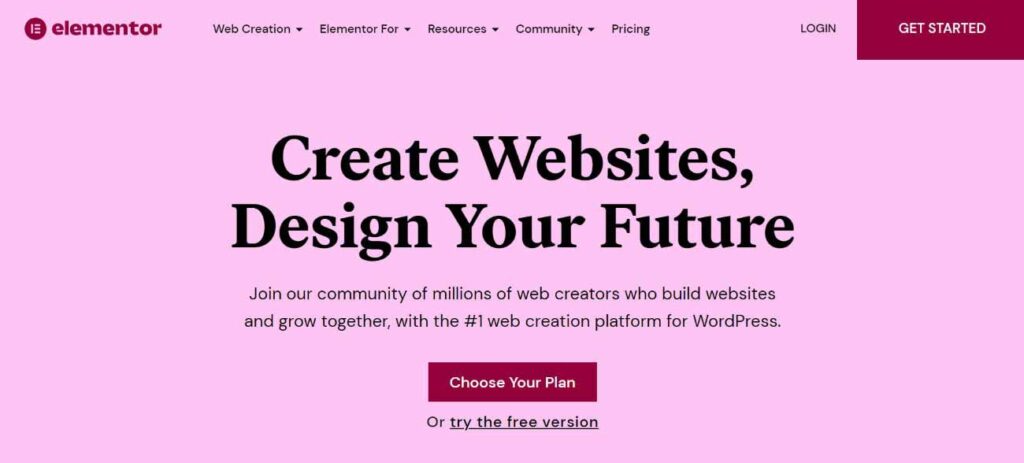
Before delving deeper into this Elementor review, let’s discuss who can benefit the most from using Elementor. One of the reasons behind Elementor’s widespread success is its versatility, catering to various types of users:
- Casual Users: If you’re not tech-savvy, Elementor offers you complete control over your website’s design. With its user-friendly visual interface and drag-and-drop functionality, you can customize your site effortlessly. Plus, there’s a wide range of templates available to kickstart your design journey.
- Marketers: Elementor includes specialized features tailored for marketers. You can easily create dedicated landing pages and leverage tools like the form widget, which integrates seamlessly with platforms like Zapier. The flexible popup builder is another handy tool for creating and refining landing pages without relying on developers.
- Freelancers/Agencies: For those building websites for clients, Elementor streamlines workflows and enables you to deliver high-quality websites efficiently. The theme builder and dynamic content support empower you to create custom content sites and WooCommerce stores tailored to each client’s needs.
While these are just a few examples, it’s important to note that Elementor can benefit a wide range of users. Its versatility makes it a valuable tool for anyone looking to enhance their website-building experience.
How the Elementor Interface Works?
Before diving into the notable features of Elementor, let’s take a quick look at how the Elementor interface functions. While I won’t dwell too much on this as you can explore it yourself by installing the free version of Elementor and experimenting with it (which I highly recommend), it’s beneficial to understand the basic functionality before moving forward.
Introducing the Interface
Elementor provides a user-friendly visual interface with drag-and-drop functionality. This means you can see your design come to life as you build it, making adjustments as needed by simply dragging and dropping elements. Typing text is as easy as clicking and typing directly on the page, similar to using any text editor. Other settings can be accessed through a sidebar.
Here’s a breakdown of the Elementor interface:
- Sidebar: This is where you can add new widgets or adjust settings for sections, columns, or widgets already on the page.
- Visual Preview: This area displays a preview of your design, including the rest of your site. Currently, it may be empty, but you’ll see a better example shortly.
- Add New Section or Insert Template: Use these options to add a new section (row) or insert a pre-designed template into your layout.
- Options Menu: Here, you’ll find tools like undo/redo buttons, options to change responsive editing modes, and more.
- Page-Level Settings: This allows you to access settings specific to the entire page.
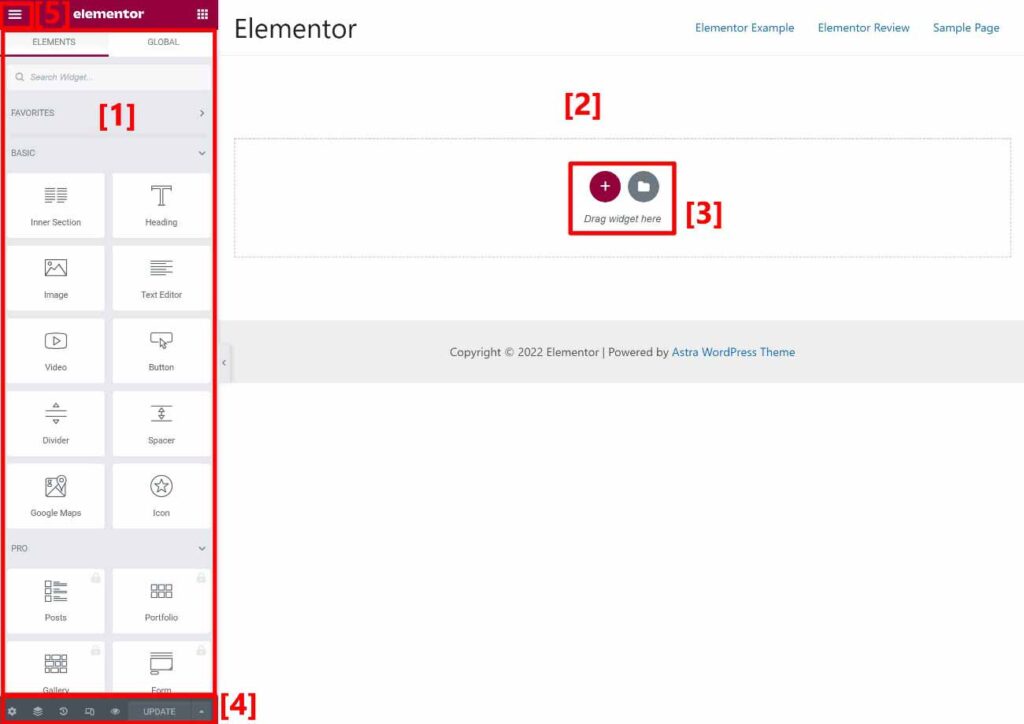
Opening the settings for a widget in a complete design is straightforward

When you want a bigger preview, just click to hide the sidebar.
More Ways to Make Your Work Easier
One of the great things about Elementor is how it makes your job simpler with some cool features. For starters, you can right-click to do things like copy, paste, or duplicate elements effortlessly. Plus, there’s a handy navigator mode that gives you a bird’s-eye view of your design. You can even label sections to keep things neat and tidy.
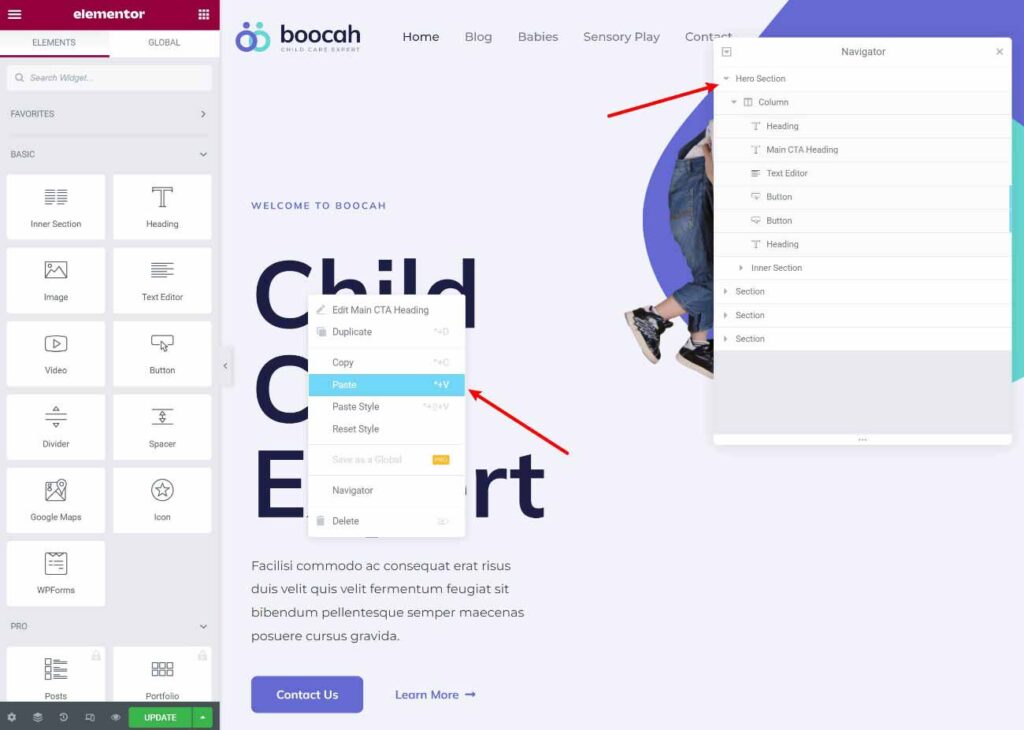
To navigate between different designs or settings areas, Elementor offers a handy “Finder” tool. This tool allows you to quickly locate and access various elements or settings on your site. Overall, the Elementor interface is designed to streamline your workflow, enabling you to efficiently create custom designs without the need for coding.
Exploring Seven Key Features in Elementor
Now that you’re familiar with the general workings of the Elementor interface, let’s delve into some of its standout features. All these features are built on the same visual, drag-and-drop interface. So whether you’re crafting a blog post, designing a popup, or creating a theme template, you’ll find yourself using the same user-friendly interface throughout.
1. Responsive Design
All designs created with Elementor are automatically responsive, meaning they adjust seamlessly to different devices like desktops, tablets, and mobile phones. However, there may be instances where you need to tailor your design based on the user’s device. For example, you might want to change text size or hide an image for mobile users.
To achieve this, Elementor provides several options:
- You can activate a responsive preview directly within the editor. This allows you to see how your design will look on different devices.
- Many settings in Elementor include a responsive control icon. This allows you to adjust specific settings for individual devices rather than applying changes universally.
- Elementor offers an option in the Advanced tab to hide content specifically for certain devices. This gives you greater control over the display of your design across different devices.
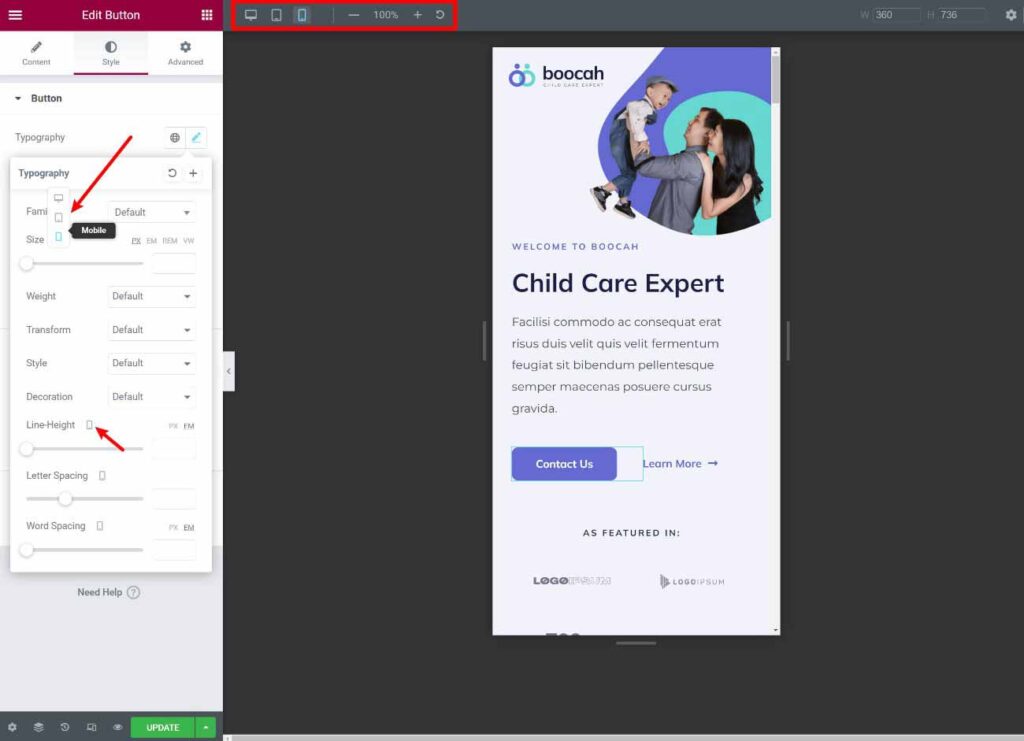
2. Tons of Design and Style Options
Elementor stands out for its extensive design options, particularly with Elementor Pro. Compared to most other builders, Elementor offers an abundance of built-in design options, rivaling only a few, like Divi Builder, in terms of design flexibility. With Elementor, you have control over various aspects of your design, including colors, typography, spacing, and more.
Elementor Pro enhances these capabilities further by providing access to custom positioning, eye-catching motion effects, and other advanced options, empowering you to craft truly unique and engaging designs for your website
3. Global Colors and Typography
Another valuable feature in Elementor is the use of global colors. These allow you to set your default colors and typography at the site level, ensuring consistency throughout your designs.
Here’s the kicker:
Whenever you update these global settings, any design elements using these defaults will automatically reflect the changes. This saves you from the hassle of manually updating each design individually. For those familiar with CSS, global colors in Elementor operate akin to CSS variables, providing efficiency and ease of management across your website’s design.
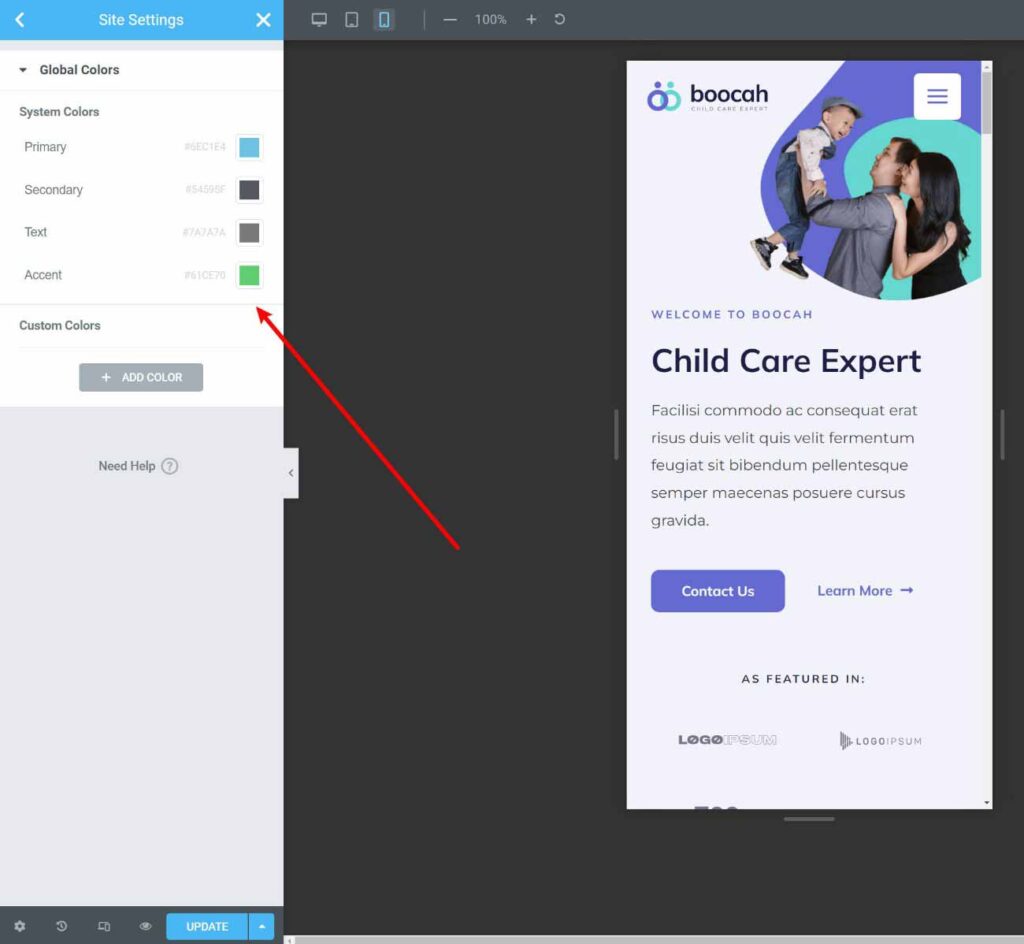
Of course, you’re not locked into using these defaults. Elementor still allows you to override them whenever necessary. This flexibility ensures that you can tailor your designs to specific needs or preferences without constraints.
4. Form Builder + Integrations
Elementor Pro offers a Form widget, essentially a form builder integrated directly into Elementor. With this widget, you can create custom forms with as many fields as required. Additionally, you can configure actions to be performed after form submission, such as sending an email or displaying a confirmation message.
Furthermore, the widget allows integration with popular email marketing services, CRMs, and Zapier. For many users, this feature eliminates the necessity of using a separate WordPress form plugin. It’s ideal for various types of forms, including contact forms and lead generation forms, streamlining the form-building process within Elementor itself.
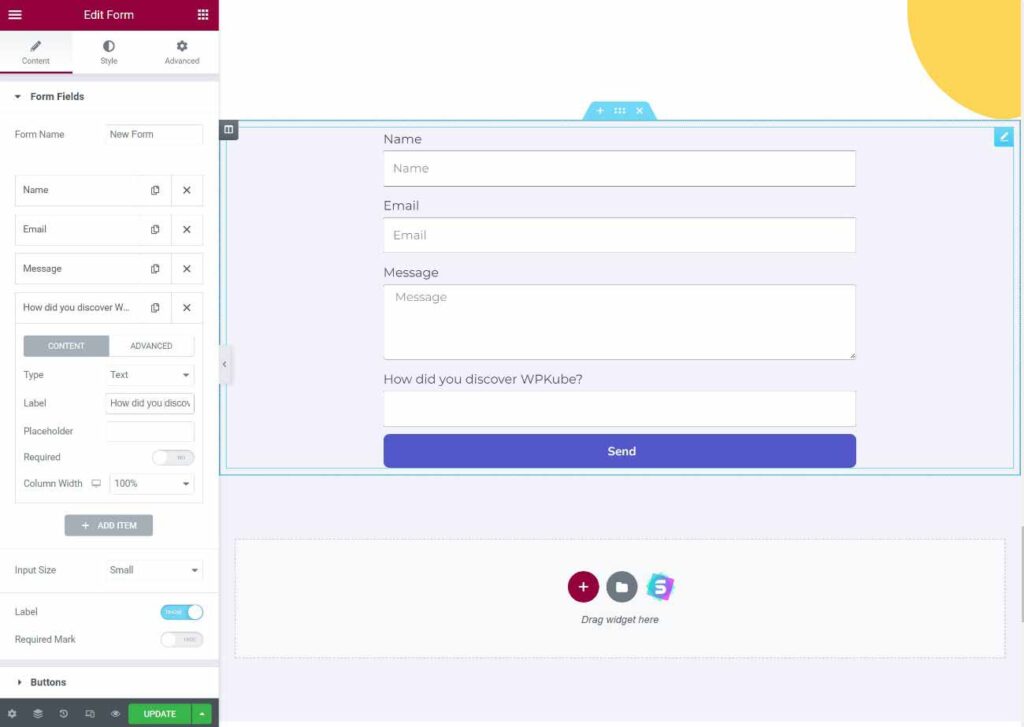
Nevertheless, if your requirements entail more complex forms with features like conditional logic, calculations, and the like, you’ll still need a separate form plugin. Fortunately, many form plugins provide dedicated Elementor widgets. Alternatively, you can explore third-party extensions that offer this functionality. We’ll delve into these options in more detail later on.
5. Theme Builder
With the standard Elementor builder, you have the ability to craft a distinctive design for an individual post or page. However, with Elementor Theme Builder, you can take your design capabilities further by customizing your theme templates. This includes designing:
- Header
- Footer
- Single
- Archive
With Elementor Theme Builder, you can design every part of your website’s theme using its visual interface, eliminating the need for pre-designed themes.
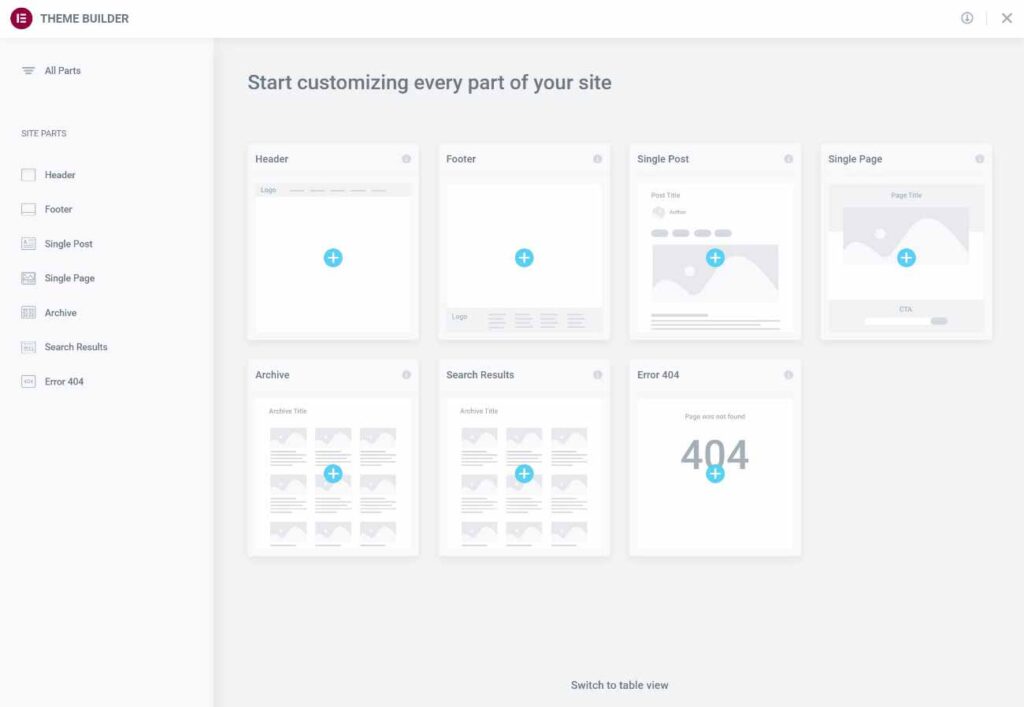
For instance, you can create a template for all your blog posts in Elementor Theme Builder. You can specify where elements like the post title, featured image, and author bio should appear. When you publish a post, Elementor automatically fills in these sections with content from the WordPress editor. To achieve this, Elementor provides dynamic theme builder widgets specifically designed for this purpose.
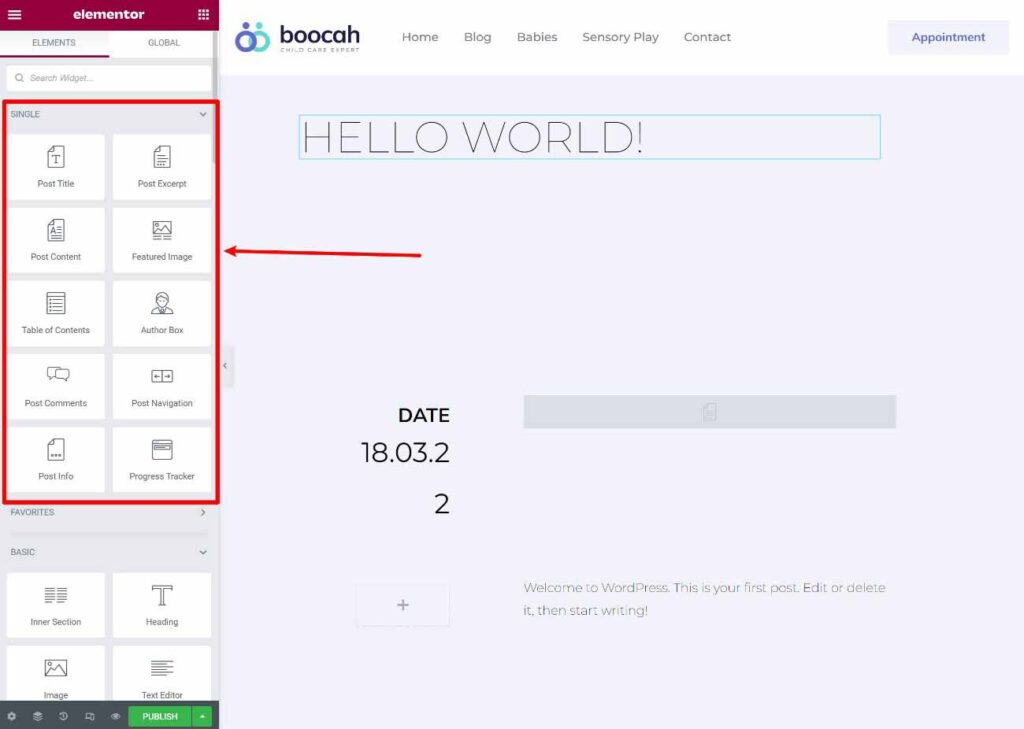
Additionally, you can utilize conditional rules to apply different templates to various content. For instance, you could assign one template for posts categorized as “Reviews” and another for those categorized as “News.” This flexibility allows for tailored designs that match the specific content types on your website.
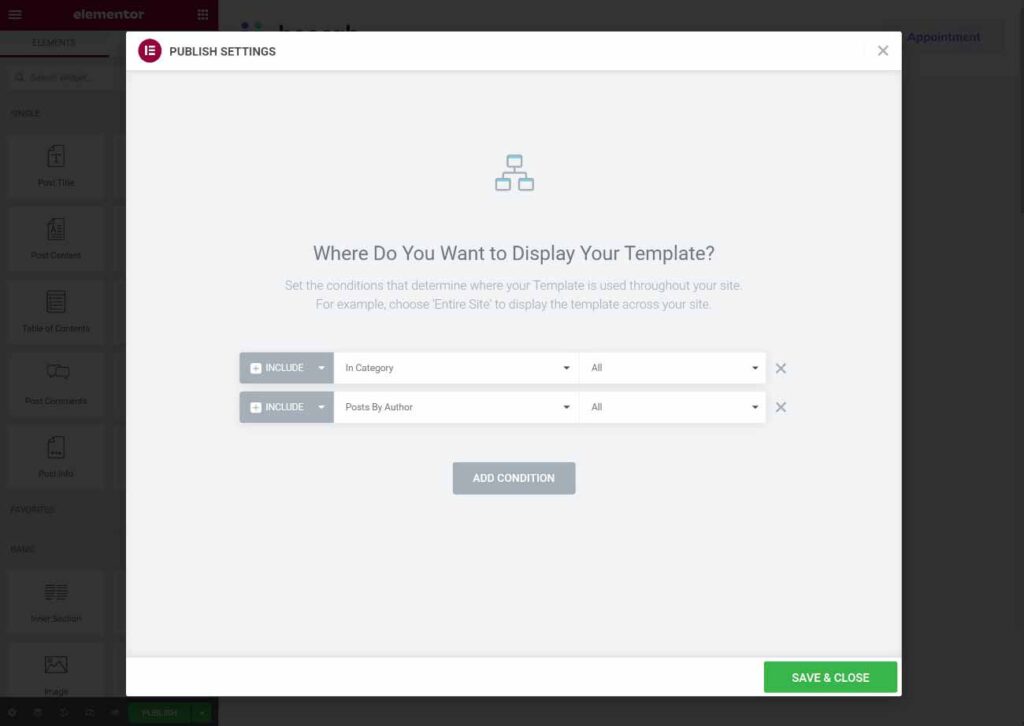
Elementor Theme Builder offers the capability to dynamically insert content into your designs from custom fields or other WordPress data when building custom content sites. This functionality includes integrations for Advanced Custom Fields (ACF), Pods, Toolset, and other similar plugins.
While it may involve a bit more complexity, this feature unlocks a plethora of possibilities for data manipulation. You can create directories, listing sites, and various other types of content-rich websites by harnessing the power of custom fields and custom post types.
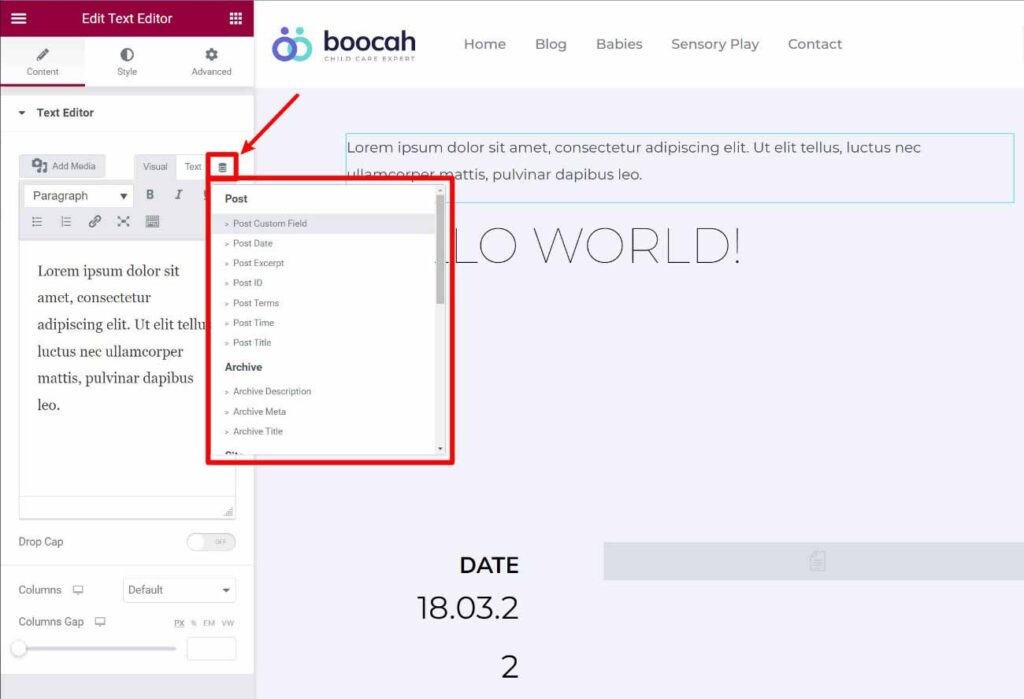
If you’re utilizing the theme builder, Elementor also provides its official Elementor Hello theme. This theme offers a blank canvas, allowing you to unleash your creativity and design without any pre-existing constraints.
6. Popup Builder
With Elementor Popup Builder, you can easily create custom popups using Elementor’s tools and features. These popups are versatile and can be used for various purposes such as collecting email sign-ups, making announcements, adding contact forms, or creating login forms.
One of the great things about Elementor Popup Builder is that you have full control over the design and layout of your popups. This means you can customize them to match your website’s style and branding. There are different types of popups you can create with Elementor Popup Builder, including:
- Lightbox popup
- Notification bar
- Slide-in
- Full-screen filler
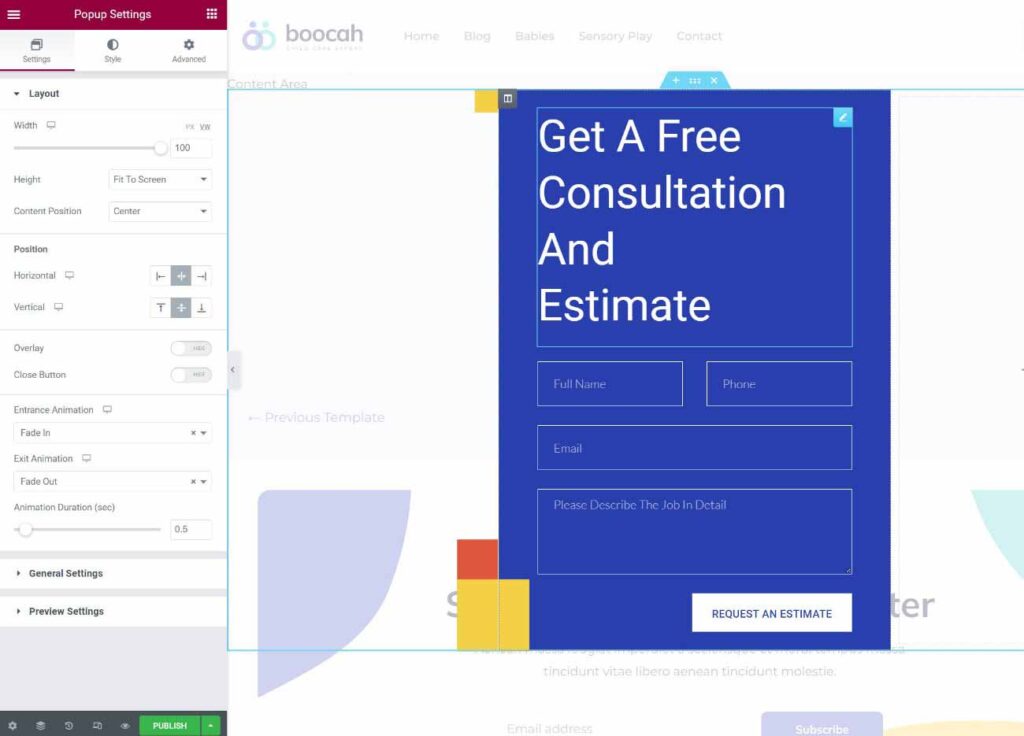
Another standout feature is the abundance of advanced targeting and trigger rules you gain access to.
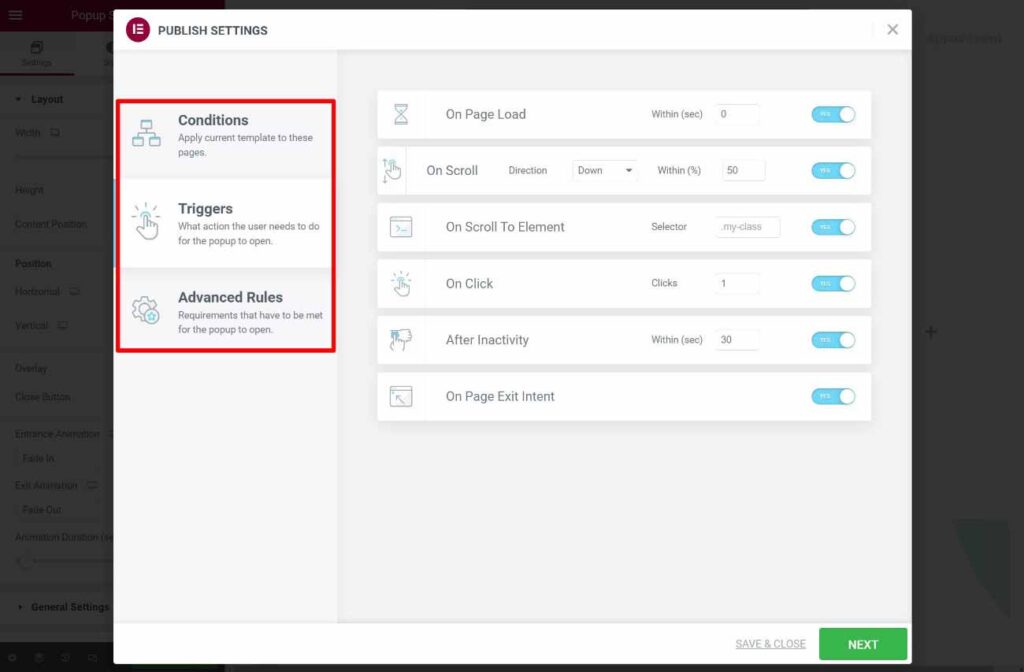
For many users, Elementor Popup Builder can serve as a comprehensive replacement for standalone popup or lead generation plugins. The only functionalities that certain marketers might find lacking are built-in analytics and A/B testing. Nonetheless, you can easily set up these features using tools like Google Analytics and Google Optimize if necessary, albeit with a bit of additional effort.
7. WooCommerce Builder
If you’re building a WooCommerce store, Elementor Pro provides comprehensive support for WooCommerce, enabling you to design your store seamlessly within Elementor’s interface. Primarily, you gain access to a plethora of WooCommerce widgets designed specifically for integrating your store’s content into unique designs.
For instance, you can utilize the Products widget to display individual products or multiple products in various layouts.
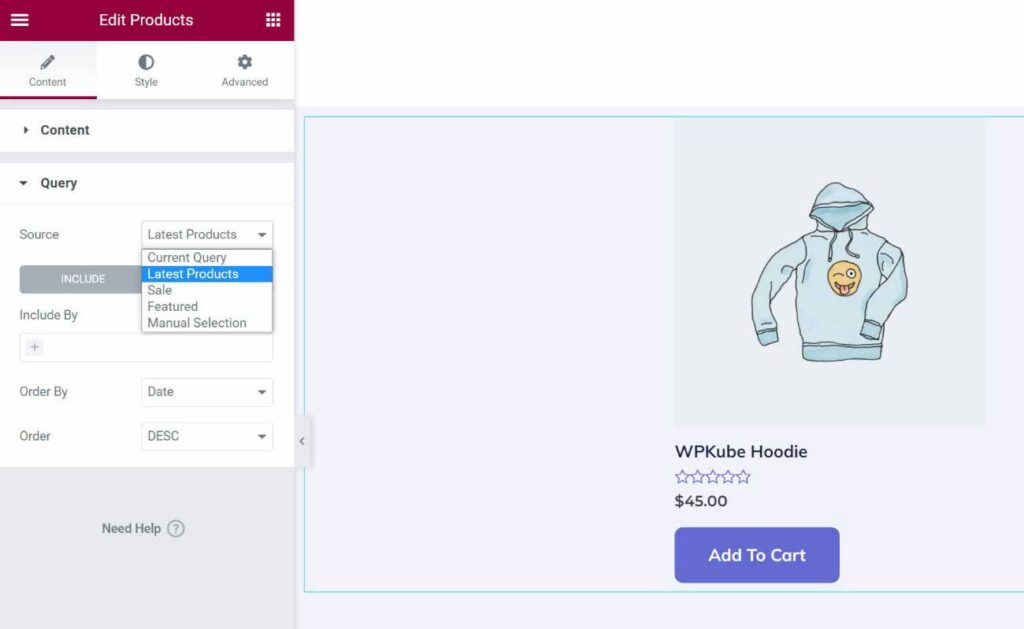
Additionally, Elementor Pro’s Theme Builder functionality allows you to design templates for your WooCommerce store. This means you can create custom templates for important pages like your single product and shop pages, ensuring they match your branding and design preferences perfectly.

Moreover, Elementor Pro offers conditional display rules, a valuable feature allowing you to create distinct templates for various product types. This capability enhances customization by tailoring the display based on specific criteria.
In early 2022, Elementor Pro introduced dedicated widgets for crucial WooCommerce pages such as the cart, checkout, and my account pages. These widgets offer extensive customization options, addressing a previous limitation of using Elementor for WooCommerce stores.
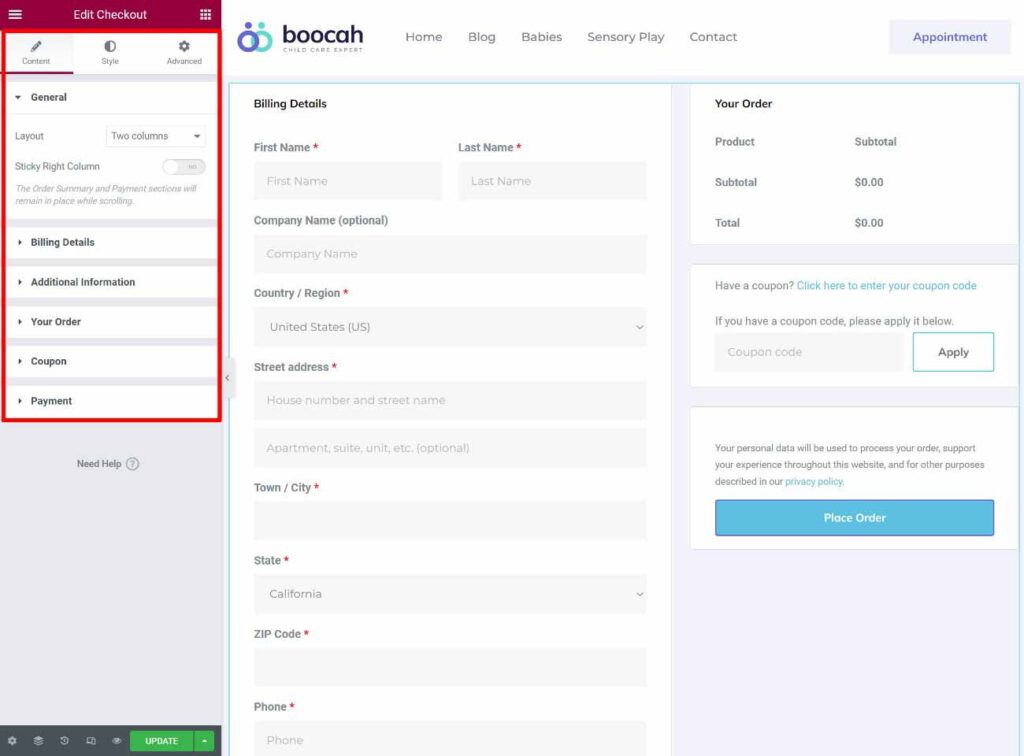
By 2024, Elementor Pro enables complete store customization via its intuitive interface.
Elementor Performance and Speed Review
Elementor offers a bunch of cool features, but using it can make your website slower. That’s just how it is. It’s heavier than the regular WordPress editor and even heavier than some other page builders like Beaver Builder. Let me show you a quick test I did where I compared all three builders and checked how much they weigh including my theme.
| Builder | Page Size | HTTP Requests |
| Elementor (w/ Speed Experiments) | 170 KB | 21 |
| Native Block Editor (Gutenberg) | 40 KB | 7 |
| Beaver Builder | 84 KB | 12 |
Now, let’s focus on some positive aspects that can provide a different viewpoint on this matter.
Firstly, the Elementor team acknowledges the importance of performance, and they’ve been actively working on reducing Elementor’s impact on your website’s speed. They’re simplifying Elementor’s structure and experimenting with loading only the necessary assets for each page, which can help speed things up.
Secondly, it’s crucial to realize that despite these challenges, you can still create fast-loading websites with Elementor. By following WordPress performance guidelines, such as using plugins like WP Rocket, you can build Elementor sites that meet Core Web Vitals standards. I’m confident in this statement because I’ve personally achieved it.
For instance, I created a demo site using one of Astra’s Elementor templates and optimized it for speed. The results from WebPageTest show satisfactory performance levels
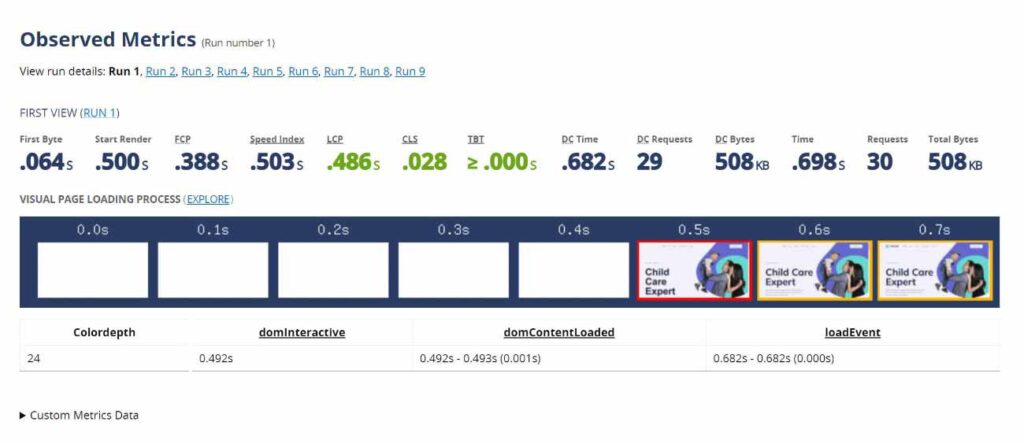
Achieving a Largest Contentful Paint time of under 0.5 seconds for an Elementor site is pretty impressive, wouldn’t you agree? Although Elementor may not be known for its performance, it shouldn’t be a reason to dismiss it entirely.
By adhering to best practices, you can still create websites that load quickly while taking advantage of all the fantastic features Elementor offers.
Elementor Cloud Website Review: Let Elementor Handle Hosting for You
Let’s shift our focus a bit from using Elementor as a WordPress plugin to exploring Elementor Cloud Website, which offers a unique solution for those who don’t yet have a WordPress site or feel overwhelmed by managing one.
In simple terms, Elementor Cloud Website provides everything you need to go from having nothing to a fully functional WordPress site where you can start building with Elementor. It takes care of creating and hosting your WordPress site and comes pre-installed with all the Elementor tools, allowing you to dive into building right away.
Think of it as a combination of “WordPress + Elementor” and platforms like Squarespace, offering an all-in-one solution with hosting and other essentials for a single, straightforward price. Overall, I found Elementor Cloud Website impressively easy to use and a convenient way to get started with building your website. Let me give you a quick review of how it works and its performance.
Setup and Usage
Elementor Cloud Website offers a simple website wizard for setting up your WordPress site when you sign up.
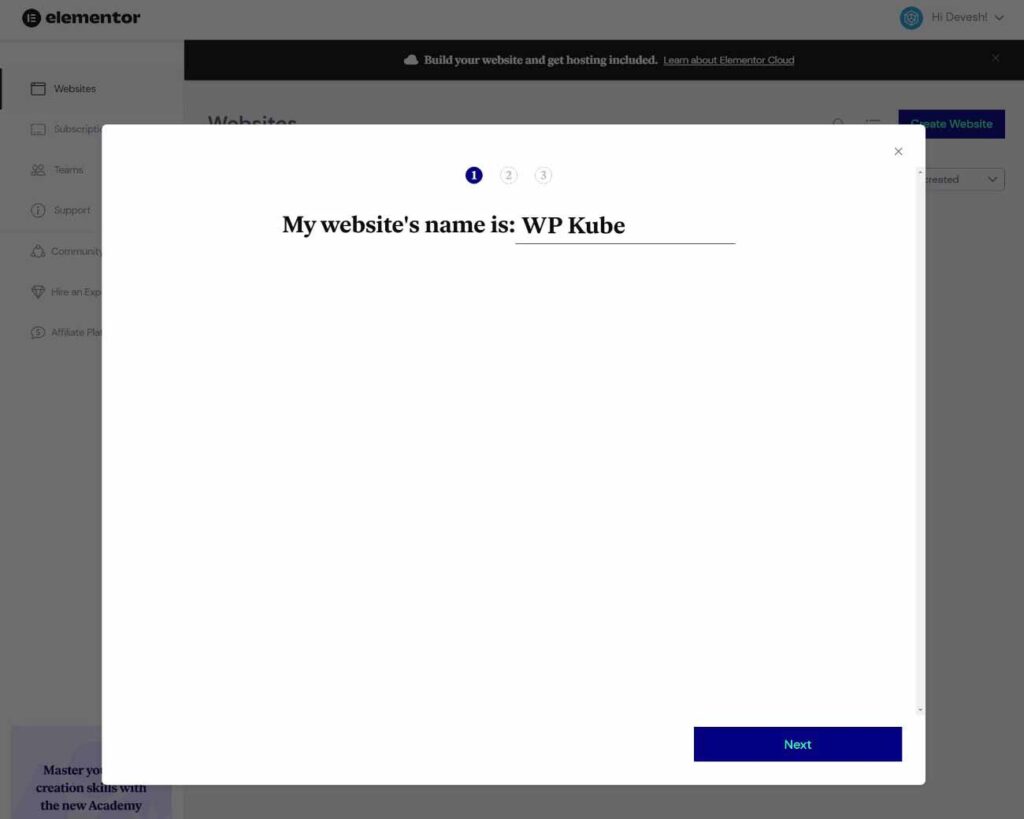
When setting up your WordPress site on Elementor Cloud Website, you have the option to choose a temporary domain. Additionally, you can later add your own custom domain if you prefer.
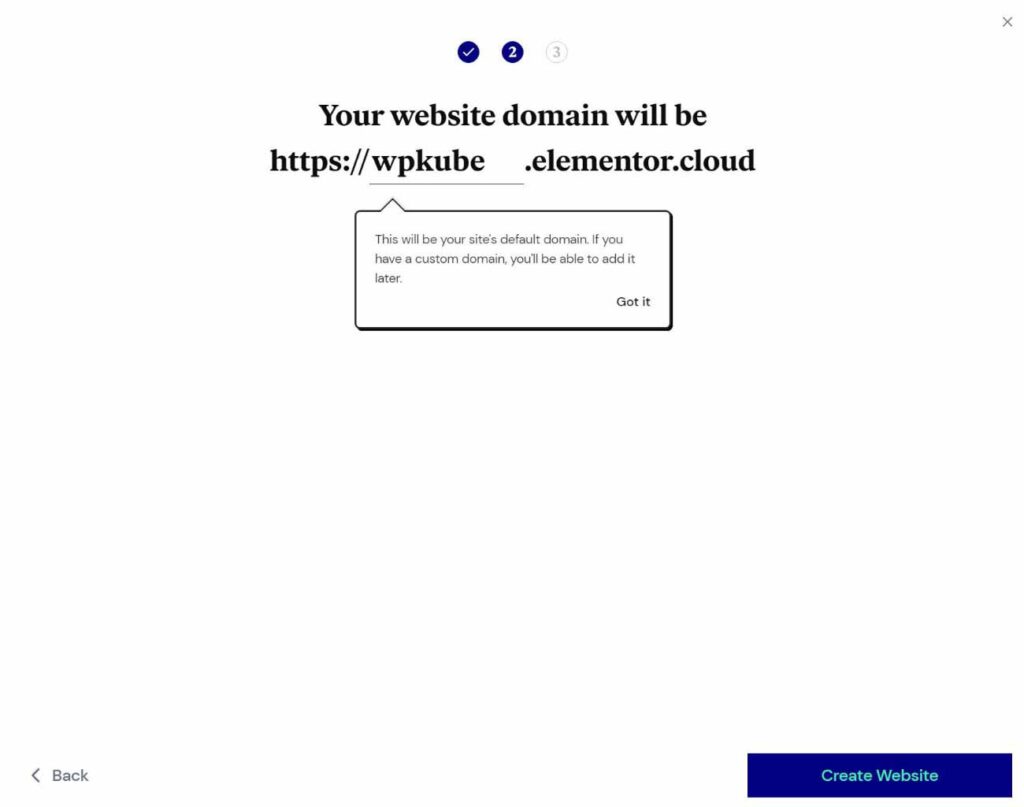
That’s all there is to it! Your WordPress site is now up and running. During the setup process, Elementor will automatically install the Hello theme along with the Elementor and Elementor Pro plugins.
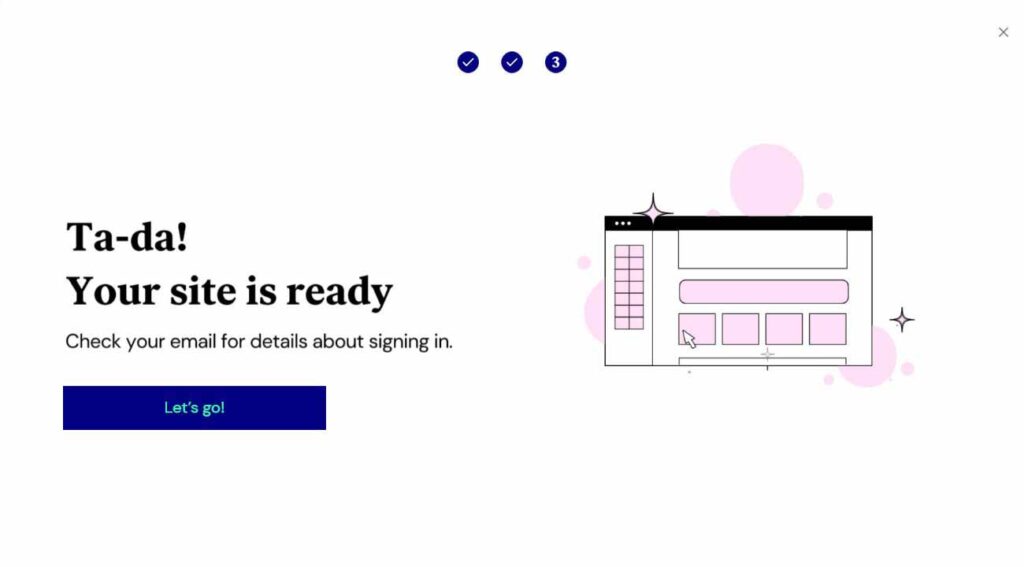
Your site operates like any other self-hosted WordPress installation, giving you the freedom to install any plugins and themes of your choice.
You’ll also have access to the standard WordPress dashboard, enhanced with additional resources from Elementor.
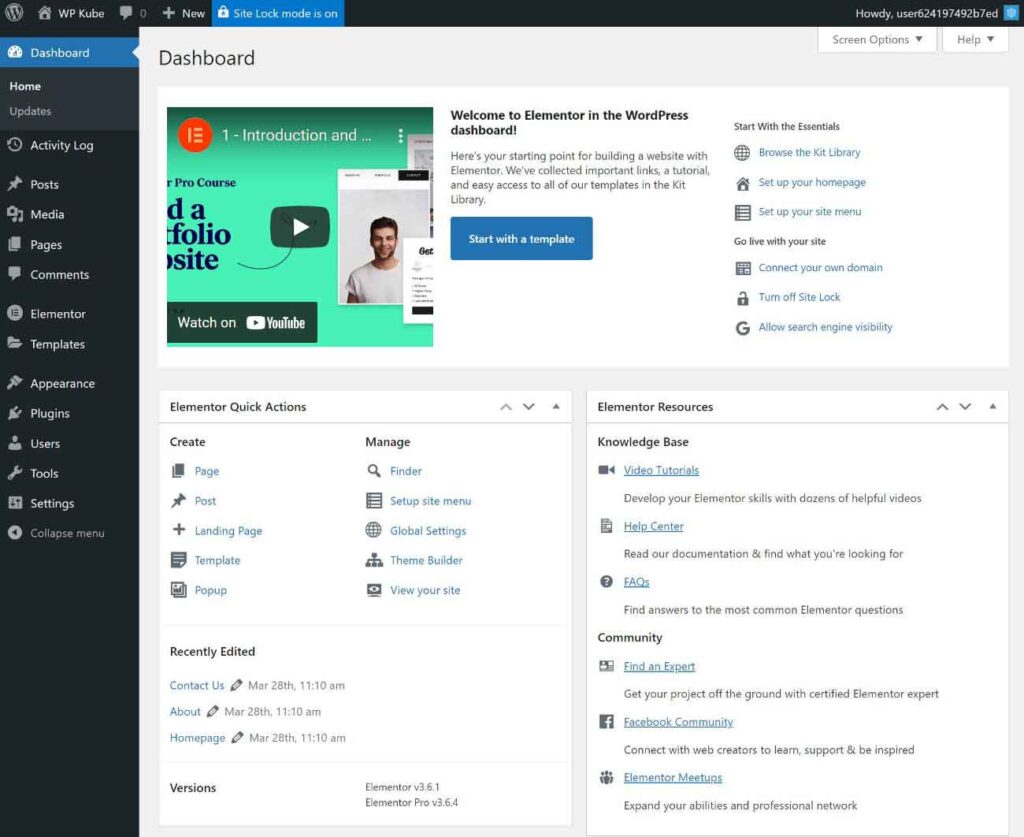
Importing one of Elementor’s full site kits is just a few clicks away. Additionally, in the Elementor dashboard, you’ll find various options such as managing backups (including downloading or restoring them), adding login protection, integrating your custom domain name, and more.
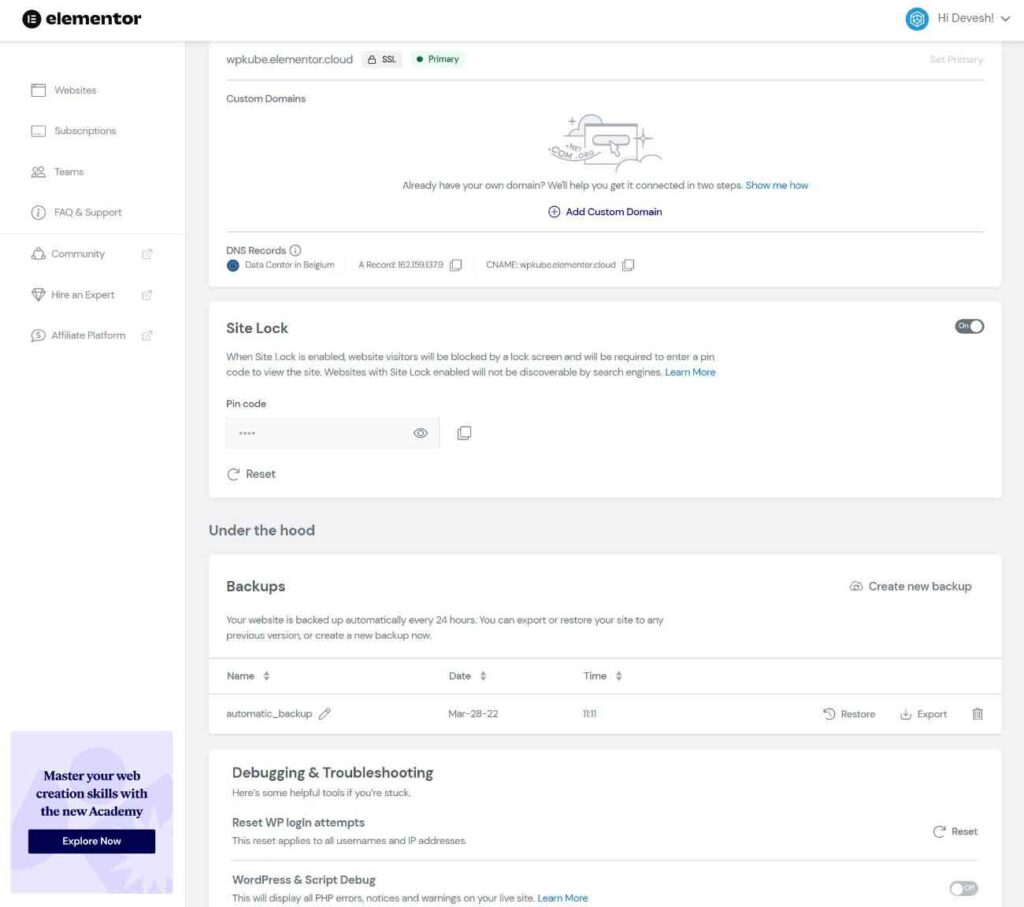
Elementor Cloud Website Performance Tests
Elementor Cloud Website, backed by Google Cloud, is expected to deliver reliable performance. To evaluate this, I imported an Elementor Site Kit and conducted performance tests. Additionally, I integrated WP Rocket to simulate real-world conditions, considering Elementor lacks built-in caching. However, I maintained fairness by using only default features in WP Rocket without any additional configurations.
Here are the results from WebPageTest:
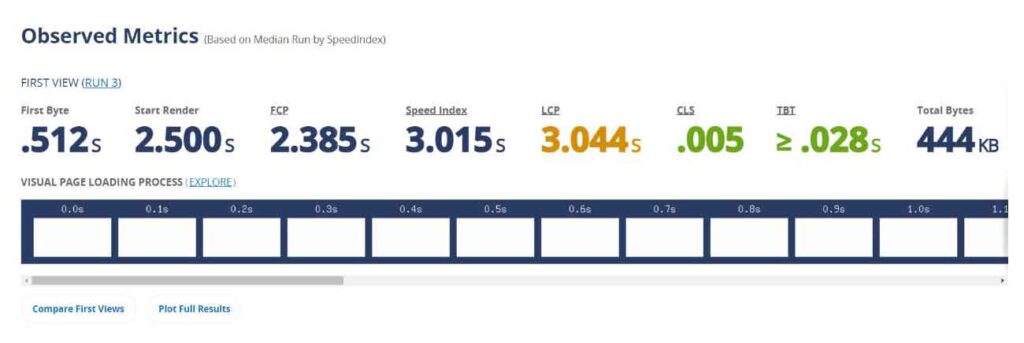
To be honest, the performance of Elementor Cloud Website isn’t on par with premium managed WordPress hosts like Kinsta or WP Engine. However, considering its price point of around $4 per month (after adding Elementor Pro), it’s hard to complain. Plus, you still get value-added features like automatic daily backups.
While a ~3 second Largest Contentful Paint (LCP) time for a full website built with Elementor may not be exceptional, it’s perfectly suitable for simple portfolios, brochure sites, and blogs. It’s still good enough for overall user experience and SEO, though ideally, aiming for under 2.5 seconds would be better, possibly achievable by further optimizing your site with WP Rocket.
For a serious website generating significant income, investing in more performance-oriented hosting like Kinsta or WP Engine (which come at a higher cost) would be wise. But for a basic site, Elementor Cloud Website remains a great value proposition given its affordability.
Third-Party Elementor Extensions: A Whole New World of Features
Up to this point in our Elementor review, I’ve solely focused on its core features and offerings directly from the Elementor team. However, one of the standout aspects of Elementor is its open architecture, designed with numerous APIs to encourage other developers to expand its capabilities.
This openness benefits users in two significant ways:
- Third-party developers can create extensions specifically tailored for Elementor. These extensions often introduce new widgets, templates, design options, features, and more, enhancing your design possibilities.
- Developers can integrate Elementor support into their plugins, even if those plugins aren’t initially designed for Elementor. For instance, a donation plugin might create a special Elementor widget for adding donation forms to your designs, or a membership plugin could introduce an option in Elementor to restrict access to certain sections or widgets.
The key detail here is that due to Elementor’s widespread popularity, it boasts the largest extension marketplace and the highest number of integrations compared to other builders. This abundance of options significantly boosts Elementor’s flexibility and usefulness, making it a standout choice among builders.
Elementor Pricing
Let’s delve into Elementor’s pricing options:
Free Version:
Elementor offers a free version available at WordPress.org. Among free builder plugins, Elementor stands out as one of the top choices. Not only does the core plugin provide more functionality than many other free tools, but users can also benefit from a vast array of free third-party Elementor add-ons. However, for access to the premium features, you’ll want to consider purchasing Elementor Pro.
Elementor Pro Pricing
Here are the prices for Elementor Pro. Note that there’s also a $99 three-site license, which isn’t included in the main pricing table:
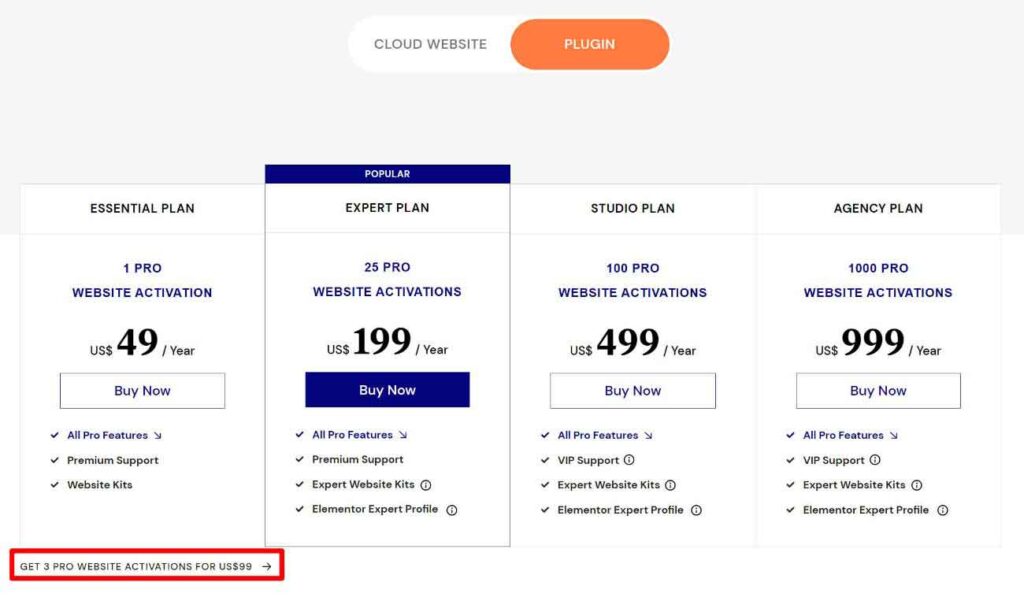
Elementor Pro’s pricing has an interesting dynamic:
- For a single site or a small number of sites, Elementor Pro is among the most affordable builders available.
- However, if you plan to use Elementor Pro for 25 or more sites, it becomes one of the pricier options.
This pricing structure primarily affects freelancers or agencies handling multiple client sites. Established agencies typically find the pricing justified considering the value Elementor offers. However, solo freelancers on tight budgets might explore cheaper alternatives to Elementor.
Elementor Cloud Website Pricing
Another option for utilizing Elementor is through the Elementor Cloud Website service. This service provides access to all Elementor Pro features and includes hosting for your website. If you believe this service aligns with your website needs, the value proposition is quite appealing: Elementor Cloud Website costs only $99 per year for one website, which covers the price of Elementor Pro features.
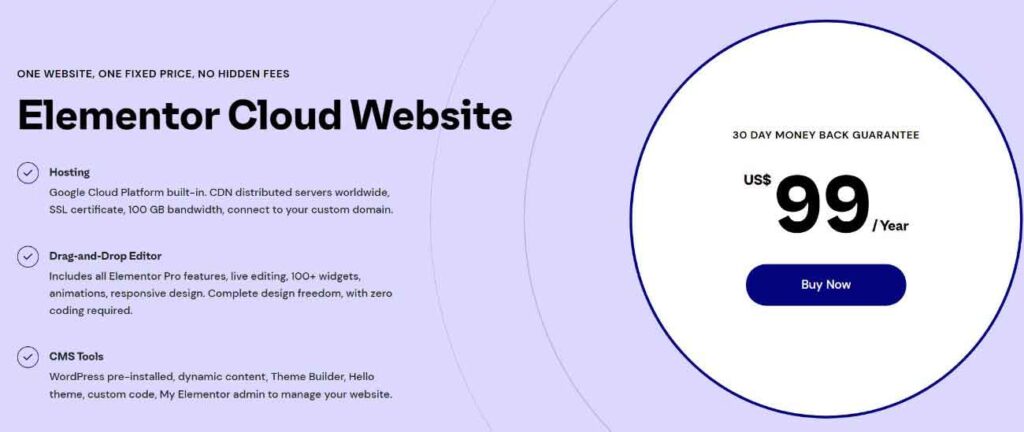
So essentially, you’re paying just $50 for the hosting aspect, equating to less than $5 per month, to host your website on Google Cloud infrastructure through Elementor Cloud Website. Considering this, and if your website falls within the limits (100,000 visitors per month), I believe this is the best deal, particularly for non-technical individuals.
Elementor Pros and Cons
As we near the conclusion of our Elementor review, let’s recap some of the pros and cons of using Elementor.
Pros:
- Top-notch features: Elementor boasts one of the most comprehensive lists of features among all builders, including a theme builder, popup builder, form widget, WooCommerce builder, and more.
- Best-in-class design options: With Elementor, you get access to unparalleled design options, offering numerous choices for responsive design, spacing, animations, and more.
- Speedy, helpful interface: Elementor provides a user-friendly interface with handy tools like right-click support, navigator mode, and finder mode, making the design process efficient and enjoyable.
- Huge third-party extension marketplace: The extensive marketplace makes it easy to enhance your website with new widgets, features, and design options.
- Strong WooCommerce support: Elementor Pro offers exceptional support for WooCommerce, with features like the Cart and Checkout widgets providing full control over your store’s conversion pages.
- Excellent free version: Elementor’s free version is one of the most powerful among all free builders, offering robust functionality without any cost.
- Elementor Cloud Website: This solution simplifies hosting for users who prefer to avoid the hassle, especially beneficial for non-technical users.
- Affordable prices for a few sites: For users needing a builder for a single site or a limited number of sites, Elementor Pro offers competitive pricing.
Cons:
- Lack of unlimited license and high prices for multiple sites: Agencies or freelancers may find the pricing structure unfavorable, especially without an unlimited site license.
- Absence of lifetime option or renewal discount: Some users may be disappointed by the lack of a lifetime payment option and renewal discounts, which are offered by other builders.
- Performance considerations: While it’s possible to create fast-loading sites with Elementor, users need to be cautious as Elementor can impact site performance if not optimized properly. However, the Elementor team is actively working to improve performance.
Elementor VS The Competition
When comparing Elementor to other prominent page builders like Beaver Builder and Divi Builder, here’s a quick summary of the main advantages and disadvantages:
Elementor vs Beaver Builder
Elementor’s Advantage
- More design options.
- Popup builder functionality.
- Better WooCommerce support.
- Enhanced dynamic content support, particularly appreciated in Elementor Pro.
- Right-click support for a convenient interface.
- Improved form widget.
- Extensive template library, surpassing Beaver Builder’s offerings.
- Built-in theme building feature included in Elementor Pro, while Beaver Builder requires a separate add-on.
- Larger third-party extension marketplace.
- More robust free version.
- Lower pricing for single-site usage.
Beaver Builder Advantages
- Easy to use – Beaver Builder is light on your website’s resources.
- Reliable – Users rarely encounter bugs after updates, but updates might take longer.
- Great value – You can use it on as many sites as you want without extra costs.
- Save on renewals – When renewing, you’ll get a hefty 40% discount.
Elementor VS Divi Builder
When comparing Elementor and Divi Builder:
Advantages of Elementor
- Easier to use interface – Many users find Elementor’s interface more user-friendly compared to Divi.
- Stronger WooCommerce support
- Popup builder included
- Improved dynamic content support – Elementor Pro’s approach to dynamic content is preferred by many.
- Enhanced form widget functionality
- More extensive third-party extension options
- Offers a free version – Divi doesn’t have this option.
- Lower cost for single-site usage
Divi Builder Advantages
- More templates available
- Included A/B testing feature – useful for marketing purposes.
- Wireframe mode for backend editing.
- More cost-effective for multiple sites – Divi Builder’s unlimited site license is cheaper when building 3 or more sites.
- Option for a lifetime license.
Final Thoughts on Elementor
Overall, I believe Elementor is the top choice for most WordPress users. While it might not suit everyone, it’s my go-to recommendation. Here’s why:
- Packed with features – Elementor Pro offers all the tools you need for building comprehensive websites, including themes, popups, forms, and more.
- Extensive design options – Elementor provides a wide range of design choices, allowing you to create exactly what you envision.
- Great value – The free version is robust, and Elementor Pro is affordable, especially for single-site users. The new Cloud Website option is also budget-friendly, ideal for those who prefer hassle-free hosting.
- Large community – Being the most popular builder, Elementor boasts a massive community with abundant learning materials, along with numerous third-party extensions and integrations.

Meet Ay Lin, your tech-savings buddy! Discover awesome lifetime deals on digital products without any fuss. Ay Lin makes it easy-peasy to upgrade your digital game without emptying your wallet. Join the savings journey and elevate your digital experience effortlessly!
